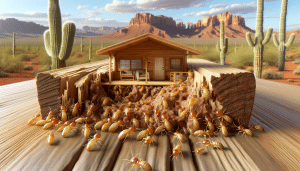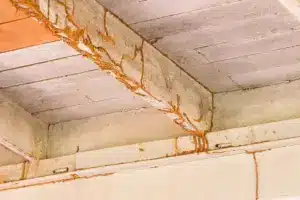Termites are small insects that can cause big problems for homeowners. These pests feed on wood and can cause significant damage to the structure of a home if left unchecked. Understanding the different types of termite infestations, the damage they can cause, and how to prevent and control them is crucial for homeowners. By taking proactive measures, homeowners can protect their homes and property from the devastating effects of termite infestations.
Contents
- 1 Understanding Termites: Identifying the Different Types of Termite Infestations
- 2 The Damage Termites Can Cause: How They Can Affect Your Home and Property
- 3 Signs of a Termite Infestation: How to Detect and Confirm Their Presence
- 4 Prevention Techniques: How to Keep Termites from Invading Your Home
- 5 Natural Remedies: Using Non-Chemical Solutions to Get Rid of Termites
- 6 Chemical Treatments: The Most Effective Termite Control Methods Available
- 7 DIY Termite Control: How to Get Rid of Termites on Your Own
- 8 Professional Termite Control: When to Call in the Experts
- 9 Termite Prevention Maintenance: How to Keep Your Home Termite-Free for the Long-Term
- 10 Taking Action to Say Goodbye to Termites for Good
Key Takeaways
- Different types of termites can cause different types of damage to your home and property.
- Signs of a termite infestation include mud tubes, discarded wings, and wood damage.
- Prevention techniques include removing moisture sources and sealing cracks and crevices.
- Natural remedies like orange oil and nematodes can be effective in getting rid of termites.
- Chemical treatments like fumigation and soil treatments are the most effective methods for termite control.
Understanding Termites: Identifying the Different Types of Termite Infestations
A. Subterranean Termites
Subterranean termites are the most common type of termite found in the United States. They live in underground colonies and build mud tubes to travel between their nests and food sources. These termites are attracted to moisture and are often found in damp areas of a home, such as basements or crawl spaces. Subterranean termites can cause extensive damage to the structure of a home if left untreated.
B. Drywood Termites
Drywood termites, as the name suggests, infest dry wood. Unlike subterranean termites, they do not require contact with soil or moisture to survive. Drywood termites can be found in furniture, wooden beams, and other wooden structures in a home. They create small tunnels within the wood and can cause significant damage over time if not addressed.
C. Dampwood Termites
Dampwood termites are attracted to moist wood and are typically found in areas with high humidity levels. They infest decaying wood, such as logs or tree stumps, but can also be found in damp areas of a home, such as bathrooms or kitchens. Dampwood termites are less common than subterranean or drywood termites but can still cause damage if not treated.
The Damage Termites Can Cause: How They Can Affect Your Home and Property
A. Structural Damage
One of the most significant risks of termite infestations is the potential for structural damage to a home. Termites feed on wood, which can weaken the structure over time. If left untreated, termite infestations can compromise the integrity of a home’s foundation, walls, and support beams. This can lead to costly repairs and even pose a safety risk for occupants.
B. Property Damage
In addition to structural damage, termites can also cause damage to personal property. They can infest wooden furniture, cabinets, and other wooden items in a home. Termites can also damage books, paper, and insulation. The cost of replacing or repairing damaged property can add up quickly.
C. Health Risks
While termites do not pose a direct health risk to humans, their presence can indirectly impact health. Termite infestations often go unnoticed until significant damage has already occurred. As termites feed on wood, they create tunnels and galleries that can attract other pests, such as ants or cockroaches. These pests can carry diseases and allergens that can affect the health of occupants.
Signs of a Termite Infestation: How to Detect and Confirm Their Presence
| Signs of a Termite Infestation | How to Detect and Confirm Their Presence |
|---|---|
| Discarded Wings | Look for piles of discarded wings near windowsills, doors, and other entry points. |
| Mud Tubes | Check for mud tubes on exterior walls, foundation, and crawl spaces. |
| Wood Damage | Inspect wooden structures for hollowed or damaged wood. |
| Frass | Look for termite droppings, also known as frass, near infested areas. |
| Noise | Listen for clicking or rustling sounds coming from walls or wooden structures. |
A. Visible Signs
There are several visible signs that may indicate a termite infestation. These include mud tubes along the foundation or walls of a home, discarded wings near windows or doors, and small holes or tunnels in wood. Additionally, homeowners may notice piles of sawdust-like frass near wooden structures.
B. Audible Signs
In some cases, homeowners may be able to hear termites inside their walls or wooden structures. Termites make a clicking sound when they are disturbed or communicating with each other. If homeowners hear these sounds, it is a strong indication of a termite infestation.
C. Smell and Touch Signs
Termites produce a distinct odor that can be detected in areas where they are present. The smell is often described as a musty or mildew-like odor. Additionally, homeowners may notice a hollow sound when tapping on wood that has been infested by termites.
Prevention Techniques: How to Keep Termites from Invading Your Home
A. Moisture Control
Since termites are attracted to moisture, controlling moisture levels in and around the home is crucial for prevention. Homeowners should ensure proper drainage away from the foundation, fix any leaks or plumbing issues, and use dehumidifiers in damp areas of the home.
B. Wood Treatment
Treating wooden structures with termite-resistant products can help prevent infestations. There are various wood treatments available, such as borate-based products, that can be applied to wooden structures during construction or renovation.
C. Landscaping and Yard Maintenance
Proper landscaping and yard maintenance can also help prevent termite infestations. Homeowners should keep shrubs and plants trimmed away from the home’s foundation, remove dead trees or stumps from the property, and avoid storing firewood or other wooden materials near the home.
Natural Remedies: Using Non-Chemical Solutions to Get Rid of Termites
A. Beneficial Nematodes
Beneficial nematodes are microscopic worms that feed on termites and other pests. These nematodes can be applied to the soil around a home to control termite populations naturally. They are safe for humans, pets, and the environment.
B. Orange Oil
Orange oil is derived from orange peels and contains d-limonene, which is toxic to termites. It can be applied directly to infested areas or used as a preventative treatment. Orange oil is an eco-friendly alternative to chemical pesticides.
C. Boric Acid
Boric acid is a natural insecticide that can be used to kill termites. It can be applied to infested areas or used as a preventative treatment. Boric acid is relatively safe for humans and pets but should be used with caution.
Chemical Treatments: The Most Effective Termite Control Methods Available
A. Liquid Termiticides
Liquid termiticides are the most common and effective method of termite control. These chemicals are applied to the soil around a home’s foundation or directly to infested areas. Liquid termiticides create a barrier that kills termites upon contact and can provide long-lasting protection.
B. Bait Stations
Bait stations are another effective method of termite control. These stations contain a slow-acting poison that termites carry back to their colony, effectively eliminating the entire population. Bait stations are placed in the ground around a home and require regular monitoring and maintenance.
C. Fumigation
Fumigation is a more invasive termite control method that involves sealing off a home and introducing a gas that kills termites. This method is typically used for severe infestations or when other methods have failed. Fumigation requires professional expertise and should only be performed by licensed professionals.
DIY Termite Control: How to Get Rid of Termites on Your Own
A. DIY Liquid Termiticides
Homeowners can purchase liquid termiticides and apply them around their home’s foundation or directly to infested areas. It is important to follow the product instructions carefully and take necessary safety precautions when using these chemicals.
B. DIY Bait Stations
DIY bait stations can be purchased and installed around a home’s perimeter. These stations contain bait that termites will carry back to their colony, effectively eliminating the infestation. Regular monitoring and maintenance are required for optimal results.
C. DIY Fumigation
DIY fumigation is not recommended due to the complexity and potential risks involved. Fumigation should only be performed by licensed professionals who have the necessary equipment and expertise to ensure safety and effectiveness.
Professional Termite Control: When to Call in the Experts
A. Extensive Infestations
If a termite infestation is extensive or widespread, it is best to call in professional pest control experts. They have the knowledge, experience, and tools to effectively eliminate termite colonies and prevent future infestations.
B. Structural Damage
If termites have caused significant structural damage to a home, it is crucial to seek professional assistance. Structural repairs may be necessary, and professionals can provide guidance on the best course of action to prevent further damage.
C. Health Risks
If a termite infestation has attracted other pests that pose health risks, such as ants or cockroaches, it is important to seek professional pest control services. They can address the underlying termite infestation and eliminate other pests that may be carrying diseases or allergens.
Termite Prevention Maintenance: How to Keep Your Home Termite-Free for the Long-Term
A. Regular Inspections
Regular inspections are essential for early detection of termite infestations. Homeowners should inspect their homes for visible signs of termites at least once a year and after any significant changes or renovations.
B. Timely Repairs
Promptly addressing any moisture issues or wood damage in a home can help prevent termite infestations. Repairing leaks, fixing damaged wood, and addressing any structural issues can make a home less attractive to termites.
C. Professional Maintenance
Engaging in regular professional pest control services can provide long-term protection against termites. Professionals can perform regular inspections, apply preventative treatments, and provide guidance on maintenance practices to keep a home termite-free.
Taking Action to Say Goodbye to Termites for Good
A. Recap of Prevention and Control Techniques
Understanding the different types of termite infestations, the damage they can cause, and the signs to look out for is crucial for homeowners. By implementing prevention techniques, such as moisture control, wood treatment, and landscaping maintenance, homeowners can reduce the risk of termite infestations. Natural remedies and chemical treatments can be used to eliminate existing infestations, and DIY methods can be effective for smaller infestations.
B. Importance of Regular Maintenance
Regular inspections, timely repairs, and professional maintenance are essential for long-term termite prevention. By staying proactive and addressing any issues promptly, homeowners can protect their homes and property from the devastating effects of termite infestations.
C. Final Thoughts and Encouragement to Take Action
Termites may be small insects, but they can cause significant damage if left unchecked. Understanding the different types of termite infestations, the damage they can cause, and how to prevent and control them is crucial for homeowners. By taking action and implementing preventative measures, homeowners can protect their homes and property from the destructive effects of termites. Don’t wait until it’s too late – take action now to say goodbye to termites for good.
If you’re looking for effective termite eradication methods, you may also be interested in learning how to prevent costly infestations in the first place. Our article on “Termites vs Your Home: How to Prevent Costly Infestations” provides valuable insights and tips on safeguarding your property from these destructive pests. By implementing preventive measures, you can save yourself from the headache and expense of dealing with a termite infestation. Check out the article here for more information.




